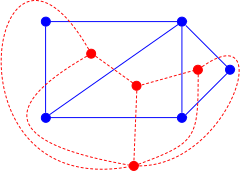Introductory examples
In the words of Michael Atiyah,
Duality in mathematics is not a theorem, but a "principle". [5]
The following list of examples shows the common features of many dualities, but also indicates that the precise meaning of duality may vary from case to case.
Complement of a subset
A simple duality arises from considering subsets of a fixed set S. To any subset A ⊆ S, the complement Ac [6] consists of all those elements in S that are not contained in A. It is again a subset of S. Taking the complement has the following properties:
- Applying it twice gives back the original set, i.e., (Ac)c = A. This is referred to by saying that the operation of taking the complement is an involution .
- An inclusion of sets A ⊆ B is turned into an inclusion in the opposite direction Bc ⊆ Ac.
- Given two subsets A and B of S, A is contained in Bc if and only if B is contained in Ac.
This duality appears in topology as a duality between open and closed subsets of some fixed topological space X: a subset U of X is closed if and only if its complement in X is open. Because of this, many theorems about closed sets are dual to theorems about open sets. For example, any union of open sets is open, so dually, any intersection of closed sets is closed. [7] The interior of a set is the largest open set contained in it, and the closure of the set is the smallest closed set that contains it. Because of the duality, the complement of the interior of any set U is equal to the closure of the complement of U.
Dual cone

A duality in geometry is provided by the dual cone construction. Given a set of points in the plane (or more generally points in ), the dual cone is defined as the set consisting of those points satisfying
for all points in , as illustrated in the diagram. Unlike for the complement of sets mentioned above, it is not in general true that applying the dual cone construction twice gives back the original set . Instead, is the smallest cone [8] containing which may be bigger than . Therefore this duality is weaker than the one above, in that
- Applying the operation twice gives back a possibly bigger set: for all , is contained in . (For some , namely the cones, the two are actually equal.)
The other two properties carry over without change:
- It is still true that an inclusion is turned into an inclusion in the opposite direction ().
- Given two subsets and of the plane, is contained in if and only if is contained in .
Dual vector space
A very important example of a duality arises in linear algebra by associating to any vector space V its dual vector space V*. Its elements are the linear functionals , where K is the field over which V is defined. The three properties of the dual cone carry over to this type of duality by replacing subsets of by vector space and inclusions of such subsets by linear maps. That is:
- Applying the operation of taking the dual vector space twice gives another vector space V**. There is always a map V → V**. For some V, namely precisely the finite-dimensional vector spaces, this map is an isomorphism.
- A linear map V → W gives rise to a map in the opposite direction (W* → V*).
- Given two vector spaces V and W, the maps from V to W* correspond to the maps from W to V*.
A particular feature of this duality is that V and V* are isomorphic for certain objects, namely finite-dimensional vector spaces. However, this is in a sense a lucky coincidence, for giving such an isomorphism requires a certain choice, for example the choice of a basis of V. This is also true in the case if V is a Hilbert space, via the Riesz representation theorem.
Galois theory
In all the dualities discussed before, the dual of an object is of the same kind as the object itself. For example, the dual of a vector space is again a vector space. Many duality statements are not of this kind. Instead, such dualities reveal a close relation between objects of seemingly different nature. One example of such a more general duality is from Galois theory. For a fixed Galois extension K / F, one may associate the Galois group Gal(K/E) to any intermediate field E (i.e., F ⊆ E ⊆ K). This group is a subgroup of the Galois group G = Gal(K/F). Conversely, to any such subgroup H ⊆ G there is the fixed field KH consisting of elements fixed by the elements in H.
Compared to the above, this duality has the following features:
- An extension F ⊆ F′ of intermediate fields gives rise to an inclusion of Galois groups in the opposite direction: Gal(K/F′) ⊆ Gal(K/F).
- Associating Gal(K/E) to E and KH to H are inverse to each other. This is the content of the fundamental theorem of Galois theory.














![Hasse diagram of the power set of {1,2,3,4}, partially ordered by [?]. The dual poset, i.e. ordering by [?], is obtained by turning the diagram upside-down. The green nodes form an upper set and a lower set in the original and the dual order, respectively. Upset.svg](http://upload.wikimedia.org/wikipedia/commons/thumb/f/f5/Upset.svg/220px-Upset.svg.png)































